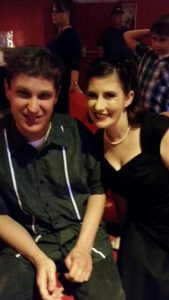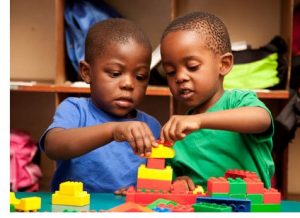Author: Jessica Akers, Ph.D., BCBA-D

“Jessica, do you know what he is saying?” This is a question I was asked numerous times growing up. My brother has Fragile X-syndrome, and his speech is not easy for everyone to understand. As a child, I frequently served as an interpreter when others, including my parents, were unsure of how to respond to his vocalizations. One of the things I appreciate most about Skinner’s analysis of verbal behavior is that it is inclusive across individuals with varying abilities. Skinner (1957) writes, “In defining verbal behavior as behavior reinforced through the mediation of other persons we do not, and cannot, specify any one form, mode, or medium. Any movement capable of affecting another organism may be verbal.” (p. 14). Although professionals labeled my brother as nonverbal, according to Skinner, his behavior simply needed to be further shaped by the verbal community. In my personal and professional experiences, I have often observed neurotypical siblings interpreting the language of their sibling with a disability, which may allow them to help their sibling refine their verbal behavior.
About 80% of Americans have at least one sibling (Dunifon et al., 2017). Siblings are often our first playmates, confidants, and in some cases even friends. They may also be our first sparring partner or rival. The sibling relationship is one that generally persists throughout our lifetime, lasting longer than the parent-child relationship. Being a sibling of an individual with a disability is unique in many ways. Outbursts in public may not be uncommon, and typical family outings may be altered based on the needs of the child with a disability. For my family, it was a regular occurrence for my brother to vomit, forcing us to leave the restaurant, hair salon, grocery store, or other location we were patronizing. In addition, siblings may become a surrogate caregiver for their sibling with a disability (Leedham et al., 2020). This can range from aiding their parents to provide additional care to assuming full-time caregiver responsibilities. Researchers report that neurotypical siblings generally express positive feelings towards their sibling with a disability, although they may also experience increased issues with mental health.

Overall, siblings play an important role in the lives of children with disabilities. Therefore, we as behavior analysts must consider how we can include siblings within our interventions. We should first consider how their lives are affected by the interventions we commonly implement. We often unintentionally ask a great deal of neurotypical siblings. For example, we recommend interventions that require minimal reactions to challenging behavior, leaving the sibling to be on the receiving end of behavior such as aggression without any recourse for retaliation. For a child, being told your sibling “doesn’t understand what she is doing” is not very comforting. To adults, it makes sense, but to a child it is simply unfair. We also frequently recommend interventions that incorporate the preference of the child with a disability, which may reduce the likelihood of the sibling’s preferences being considered when determining family activities or purchasing new items such as toys or games. Additionally, we recommend interventions that are time and labor-intensive, thus requiring the parent’s attention to be diverted to an even greater extent to the child with a disability. I am not implying that we should stop implementing effective interventions, I am simply suggesting that we engage in some perspective-taking exercises and consider how the proposed intervention impacts ALL family members.
Hopefully, by this point, I have convinced you that considering the impact our interventions have on siblings is important. However, I have not yet established why we should consider including them in our interventions that target language and play. The most obvious reason is they are readily available. Of course, a convenient sample alone is not sufficient reasoning. Returning to the introduction of this post, neurotypical siblings may already serve as effective listeners for the child with a disability because of their extensive history with one another. Therefore, the training for the sibling will be less time-intensive when compared to training a non-sibling peer. In addition, siblings may have made-up games shared just between the two of them. For example, as young children, my brother and I played a game that was a version of tag, but the rules of the game were made up and shared between us alone. It could be possible to insert teaching opportunities during these shared games, which would not be possible with another peer. Returning to the example of tag, the behavior analyst could ask the sibling to model and wait for their sibling with a disability to say “again” before beginning another round of the game. Finally, because siblings are already familiar with one another, establishing rapport during sessions is not required as it likely would be for a non-sibling peer. The behavior analyst can build rapport more quickly with the sibling as well because of the increased availability.

So, the question remains, what can we as behavior analysts do to include siblings within our interventions, specifically those targeting verbal behavior? We have data to suggest the inclusion of siblings within interventions targeting language during play is effective. For example, my colleagues and I examined whether neurotypical siblings could implement a script-fading procedure and whether this intervention would result in an increase in commenting during play for their autistic sibling (Akers et al., 2018). We found that neurotypical siblings implemented the procedures with fidelity and the intervention was effective. Although this intervention was implemented during play, the sessions were structured with specifically taught phrases. Researchers have also investigated the impact of including siblings within naturalistic interventions. Spector and Charlop (2018) trained neurotypical siblings to implement the Naturalistic Language Paradigm. These researchers observed an increase in speech behavior for the children with autism once the intervention was introduced.
Based on research and personal experience, I have created a list of suggestions for successfully including siblings within behavior analytic interventions. This list is in no way exhaustive, it is just a starting point.
- Determine whether the sibling is motivated to participate in the intervention. Siblings are already asked to go above and beyond for their sibling with a disability and we as behavior analysts do not want to unnecessarily add to their responsibilities. For example, provide the sibling with two options for activities, one that includes their participation in the intervention and another unrelated option. Use what we know about choice to keep the response effort and quality/quantity of reinforcement equal across the two options. If one option is to teach their brother with a disability to request toys and the other is to watch television, most children will select the latter.
- Include feedback from the sibling when selecting goals. For example, if the sibling reports that they wish their sibling with a disability could talk about their school day such as what activities they participated in during recess, a goal targeting delayed reporting of activities could be developed.
- Incorporate the preferences of both children. For example, if you are planning to conduct a preference assessment to identify materials to include within the intervention, consider conducting a preference assessment with the sibling as well as with the child with a disability.
- There are three typical roles that peers fill within interventions. They can serve as the implementer of the intervention, a model for appropriate behavior during the intervention, or an additional recipient of the intervention. The research studies discussed above are examples of the sibling serving as the implementer. Siblings could serve as models if they were asked to participate in sessions without implementing or receiving the intervention. For example, I have implemented script-fading procedures with children while they are playing with peers. The peer was not asked to implement the procedure nor were they prompted to emit scripted phrases, thus they served as a model. My colleagues and I have conducted research in which children with autism and neurotypical peers were taught to follow an activity schedule to play hide-and-seek (Akers et al., 2018). If a sibling were included instead of a peer, this would be an example of the sibling receiving the intervention. This type of inclusion may be ideal for including siblings because it does not require the siblings to be placed in differential roles where one sibling is in a more dominant role. In addition, the expectations for the sibling would be lowered as they would not be required to teach their sibling new skills.
- When possible, provide the siblings with opportunities to connect with other siblings. Having the opportunity to form a verbal community with others who share similar experiences is an important strategy to mitigate the difficulties of growing up with a sibling with a disability. For example, the Sibshops organized by the Sibling Support Network provides an opportunity for siblings to meet and interact with other siblings. They provide a safe space for siblings to discuss the good and the not-so-great aspects of having a sibling with a disability. If a less formal arrangement is preferable, consider organizing a sibling-only event with activities such as bowling or mini-golf.

This list of suggestions will undoubtedly increase as research and practice shift toward the inclusion of siblings. I hope this post inspires further conversation and action related to including siblings within interventions targeting language and play.
“Siblings will take different paths and life may separate them…but they will forever be bonded by having begun their journey in the same boat.” Unknown

Jessica S. Akers, Ph.D., is an Assistant Professor of Educational Psychology, specializing in Applied Behavior Analysis. Dr. Akers completed her post-doctoral fellowship at the University of Nebraska Medical Center, working in the Munroe-Meyer Institute. She received her Ph.D. in Disability Disciplines with a specialization in Applied Behavior Analysis from Utah State University and her B.A. and M.A. in Psychology from California State University, Fresno. Dr. Akers is a Board Certified Behavior Analyst-Doctoral Level (BCBA-D). Dr. Akers’ research interests include strategies for promoting appropriate social and play skills and verbal behavior in individuals with autism and related disabilities. She is primarily interested in targeting appropriate play between children with autism and their typically developing peers and siblings.
